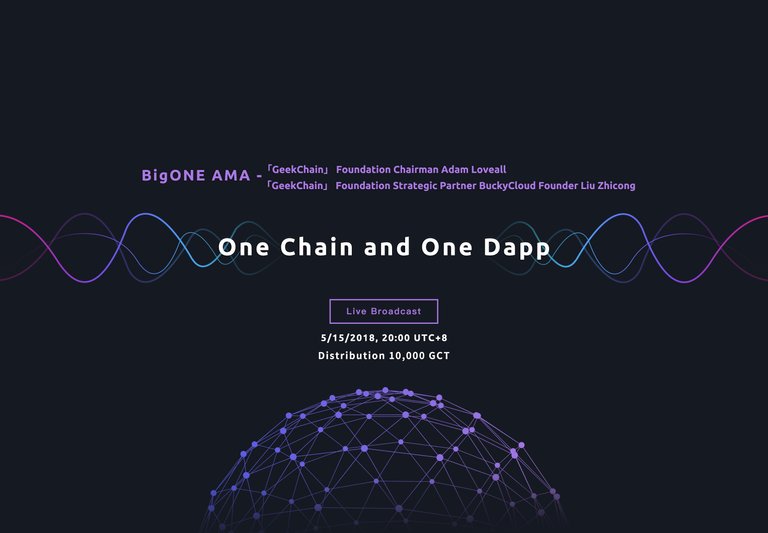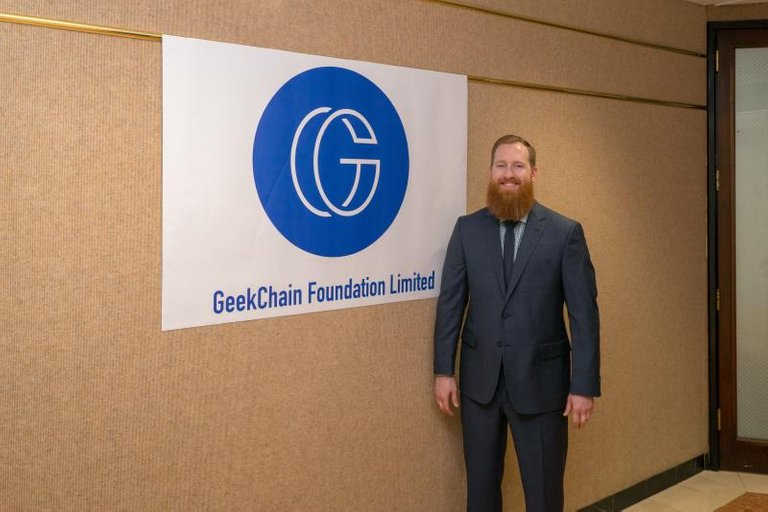
One Chain and One Dapp

Adam:
First, I’d like to thank currency exchange BigOne for providing this opportunity for us to discuss the GeekChain project here. I have been hearing from many early Bitcoin adopters/loyalists expressed their concern over the highly centralized node of Bitcoin today. They believe that the current distribution of Bitcoin's computing power is against the Original intention of Satoshi Nakamoto, despite the fact that it was determined by the consensus of the POW. On the contrary, EOS is using a new consensus mechanism to introduce the limited “supernode” approach, which I think is their biggest innovation.
I believe the transition from Bitcoin to Ethereum, and then to EOS is an important process in the development of blockchain technology, and EOS is by no means the final state. We are here to promote the development of the GeekChain framework and the implementation strategy of the future GeekChain computing node. The current technology trend of blockchain is to create a more effective decentralized distributed solution. And let’s do not forget, any distributed system has an impossible trinity of balancing "security, speed, and cost," But we are optimistic that the underlying technological advances in GeekChain can develop and better balance the impossible trinity under our efforts.
The vision of the GeekChain Foundation is to utilize global cutting-edge resources and to develop a “one chain and one Dapp” technology architecture in order to build a smart node next-generation blockchain application ecosystem. What we are promoting here is the next generation of blockchain and its ecosystem. If bitcoin implemented trusted ledgers and ETH implemented trusted codes, then we would like to explore the new dimension of the blockchain: trusted systems. Our trusted system will run on a large number of untrusted end-user devices, but it can feature all the functions of a traditional centralized system.
Next, I will elaborate on our foundation vision in three aspects.
Let me first explain the "one chain and one Dapp" system architecture.
Blockchain platforms based on "smart contracts" sound good on paper, but it is impossible to achieve a good balance of performance, cost, and security on such chains given the limitation of today's hardware and network. We are going back to the basics of blockchain technology, and to make fundamental changes on the underlying technology and infrastructure, so that every blockchain project team that is trying to develop Dapp can design and develop their network based on their unique use cases, and not to wait for a big, universal public chain.
In order to achieve this goal, we had come up the "one chain and one DApp" architectural idea. The DApp team will complete the development of DApp based on ChainSDK rather than using a generic main chain. After their development is completed, every DApp team will get their DApp on their main chain. In the development process, you can choose your own blockchain key application technology (including the definition of block size, consensus algorithm, etc.) by constructing a configuration file. You also have the option of using the traditional programming language (JavaScript is supported) to develop based on your unique business requirements (smart contracts).
The GCT Foundation is very honored to be able to work with BuckyCloud, the world's leading technology development team in the P2P field. The BuckyCloud team has decades of experience in the field of designing and running large-scale P2P systems. They will lead the effort of promoting the development of the ChainSDK within the communities. BuckyCloud will also aim to introduce a set of toolchains to lower the difficulty of developing your own main chain.
Next, I would like to talk about "smart node infrastructure".
Every home router is your home gateway, normally online and has access to internet 24/7. The current smart routers also have the computing power and storage capability, so it can serve as a natural distributed storage and computing node. Home router’s role in the blockchain network will soon be recognized and will have far-reaching significance, reflecting the true definition of Blockchain networks such as decentralized storage and calculation, and it truly returns the power to users.
We are very pleased to have the opportunity to partner with China's industry leader HiWifi. In the past 4 months, we have been evaluated the technical architecture with HiWifi team, based on many factors such as the smart home gateway technology, hardware expansion capabilities, manufacturing costs, data processing, and total user base. A number of technical verifications of the future use cases were carried out using several HiWifi several flagship models. I’d like to announce that the results obtained are very satisfactory.
And more importantly, we have established the consensus that the smart home node in the future will be automated. Our company had formally signed the contract to form strategic partnership in early April of 2018, and consequently, HiWifi became the first eco-partner of the GCT Foundation.
In the near future, the GCT Foundation will continue to collaborate with HiWifi to further promote blockchain smart nodes, and to utilize the current infrastructure of two million HiWifi routers to build the “one chain, one dapp” infrastructure.
The owners of HiWifi’s blockchain routers will become early adapters of the new eco-system by sharing idle network resources, idle computing resources, and by contributing storage space. The goal is to provide public network nodes that can be configured dynamically for the development and testing of the application chain, and also to provide enough public network nodes for the “cold launch” of the application chain project, which will greatly improve the development efficiency of the development and to speed up the real-world implementation of DApp.
Last but not least, I want to talk about GCT tokens and its circulation.
The GCT Foundation has carefully designed an eco-system based on fairness and openness of our public chain. Every party in this system can promote development driven by their own interests and can share the benefits of applied technology. We created the GeekChain Token (GCT) for this sole purpose.
In the early stage of the economical cycle in our eco-system, DApp development team configures each individual project based on the scale of the project and development nodes and uses GCT to purchase nodes. Smart node owners get GCT as reward by providing computing power and storage in the form of mining. Blockchain developers can earn GCT by contributing code to become a driving force in the community, and hardware manufacturers generate value in GCT in the form of hardware sales.
During the later and more advanced stage of the eco-system, each GCT address will receive the extra GCT reward, which will greatly ensure the long-term growth of the GCT asset value. This is the consensus of constructing the GCT economical cycle.
The ecological construction and economical cycle of GCT can be seen in Figure below:

The GCT Foundation is actively promoting the project. Our strategic partners within the community have demonstrated great interest and efficiency. Wang chuyun, founder of the GEE, and Liu zhicong, founder of buckycloud, are both typical geeks, and their ideas and abilities are admirable. We are open to working with global leading smart hardware manufacturers to build a community along with the top blockchain developers in the world. We are inviting more DApp implementation team to join us to speed up the development of blockchain technology.
Q & A Part:

1.Recently GCT launched a BDT Beta test invitation on their official website, what is the purpose of this beta test?
Liu Zhicong:
Hello everyone, my name is Liu Zhicong from BuckyCloud, I will answer this question.
The blockchain technology can be divided into three layers in terms of its architecture. The bottom layer is the non-centralized P2P network, with a consensus engine as the middle layer, and business logic as the top layer. Because most of the blockchain teams on the market now are US-based, and their focus is on the consensus engine (consensus algorithm research) and business logic support (comprehensive methods for writing smart contracts). Their underlying network layer is commonly based on TCP/DHT, which is also widely accepted by the industry.
The TCP/DHT based protocol stack was the mainstream solution for eMule around the year 2000. While it is widely accepted in the United States, where has the ton of IPv4 addresses in their network, but it caused many problems in China, where there is a shortage of IPv4 addresses, also a large number of nodes are behind the multi-layer routers. I have an in-depth understanding of the network access situation in China, learned from many years of P2P system development at XunLei.
The GCT Foundation hopes to convert a large number of home smart devices into future blockchain nodes and to do that it requires a new P2P protocol tailored for China's network environment. BuckyCloud has been working on BDT protocol since it was founded back in 2016, learning from our shortfall from Xunlei, and including a better multi-layer NAT support, IPv6 support, discovery on decentralized SN, and carrier-friendly DHT structure. So after 14 months of R&D, we have accomplished the proof the concept and completed the initial code development and laboratory testing, ready for the real-world experiment.
At that point of time, we were approached by GCT Foundation. We began to optimize the protocol for the new application scenario of the blockchain. As for the strategic partnership, GCT Foundation can help to push testing of the BDT protocol in a real-world production environment. From my past experience with Xunlei, the cycle of a new protocol from design to production testing was generally more than one year, and it also requires rigorous testing and data analysis to promote and improve the new protocol. I would also like to point out that there are very few teams in this industry other than us have full P2P protocol development experience.
The BDT protocol is now entered a critical phase of testing, verification, and optimization. Our goal is to complete the 1,000-node test, 10,000-node test, unlimited-node test, and then to release the official version of the protocol later 2018. We did not expect to have such a large platform like this after I left Xunlei. We will continue to advance the implementation of the new protocol with industrial-grade processes and quality requirements. At present, we have received strong support from the GCT community for conducting 1,000-node test. This is truly the power of decentralization that we could not imagine in the past. We will try to live up to the expectations set by GCT Foundation and release the official version of the BDT protocol this year.
2.GCT is an ERC20 token, so do GCT foundation have a plan for developing and launching your own parent blockchain? What is the value forecast of GCT tokens in various DApp projects based on "one chain and one DApp" concept?
Liu Zhicong:
I will take this question as well.
GeekChain is indeed a parent blockchain development project based on the concept of “one chain, one DApp”. The current development plan is to have the BETA version available for testing at the end of June this year. The official release timeline will depend on the test results. As the parent blockchain goes live, we will utilize the Ethereum smart contract to convert the GCT from ERC20 onto new parent blockchain. As previously mentioned in the GCT white paper, there are two main functions of GCT tokens:
(1)After the user makes his/her smart device into the public-blockchain project node, the project team will pay extra GCT to the user in addition to the tokens earned by user’s smart device.
(2)Profit is being generated in the entire GCT ecosystem, coming from several different DApps. The profit will be converted into GCT tokens and distributed to GCT existing holders.
3.I have been a loyal user of HiWifi router. Now since my router has the mining capability, I would like to ask: what is your algorithm for mining? Can I set up a mining pool using multiple HiWifi routers?
Adam:
Hi, first let me welcome you to be an important part of GCT eco-system as a GCT miner.
The algorithm of mining using a HiWifi router is determined by your device's computing power, storage capacity, and data transmission efficiency of the network. You can earn GCT and ACT Tokens using high-end HiWifi devices. We will introduce more ways of earning token rewards as the Dapps development and eco-system moves forward.
As an integral piece of the GCT eco-system, HiWifi devices will continuously be upgraded as GCT project moves forward, and mining mechanisms will continue to improve. There are many factors being considered in the GCT operational planning, including the mining ability and the hardware capabilities of the HiWifi devices, the consensus algorithm for the assigned project, and the duration of the GCT held by the current equipment’s binding address.
In the current mining algorithm, connecting multiple routers or bridges to a single network IP, will not increase the mining ability. Also, your scenario is not economical for average families. As an existing member of the GCT mining community. you can refer other HiWifi users to upgrade their routers to start mining. We will mark you as a referrer for all the miners you had referred, your mining efficiency will greatly be improved as a mining referrer.
In the early days of GCT eco-system, the device mining capacity was less affected by the age of the account holder’s GCT tokens. Currently, our goal is to distribute GCT to early adopters as evenly as possible. The age of GCT tokens and hardware capacity will play a bigger role in mining capability in the next phase and resulted in the greater income difference.
4.Does GCT foundation operate internationally? I see your strategic partners are all China-based teams. Do you have partners from other countries?
Adam:
The GCT Foundation currently has offices in the United States and China. We decided to focus on the Chinese market and community in the early stages of operation because China’s R&D of smart hardware and P2P protocol is world-class. Although the Chinese government had imposed legal restrictions on cryptocurrency transaction and distribution, it did not slow down the development of blockchain technology in China. GCT is very optimistic about the rapid advancement of blockchain technology in China. However, the development of the GCT community will inevitably require more participation of other international smart hardware owners and developers. Few smart network device manufacturers and DApp project teams had reached to us. We will actively take the initiative to include more strategic partners to participate in our project.
简体中文版:
一链一应用
Adam:
十分荣幸我们能在此共同探讨极客链项目,感谢币一交易所。我经常听到很多早期坚定的比特币信仰者,都对比特币今日高度中心化的算力节点表示担忧,他们认为当前的比特币算力分布有违中本聪的初衷,但我们都很清楚这是由POW共识决定的。而EOS选用了新型的共识机制,以确定和有限的“超级节点”的方式实现了创新。
而我们认为无论是比特币还是以太坊亦或是EOS,都是区块链技术发展中的重要进程,但绝不是最终状态。我们正在推动发展的极客链开发架构和算力节点实现策略,可能更具未来感一些,我们深信区块链的技术发展方向最终是向更加有效的去中心化的分布式演进的。当然,我们都很清楚分布式系统有一个称之为“安全性、速度和成本”的三元悖论,但我们乐观的认为在极客的努力之下底层技术上的进步可以让这个3个特性都得到发展。
极客链基金会的愿景就是:整合全球尖端资源,通过开发设计“一链一应用”的技术架构,构建智能节点完备的下一代区块链应用生态。我们在推动的正是下一代的区块链开发和运营生态的实现。如果说比特币实现了可信任的账本,ETH实现了可信任的代码,那么我们希望能去深度探索区块链的一个新维度:可信任的系统。这个可信任的系统运行在大量的不可信的用户设备上,却能完成今天互联网上一个中心化系统的全部功能。
接下来,我将就三个方面为大家进一步阐述基金会的愿景。
我先来解读“一链一应用”的区块链系统架构。
我们认为基于“智能合约”的区块链平台虽然理论上很完美,但在今天的硬件和网络水平下是无法在一个主链上实现性能、成本和安全的良好平衡的。我们回归区块链技术的本源,并在区块链的底层技术和基础设施上寻求进展,让每一个试图开发DApp的项目团队都可以根据自身的应用逻辑设计开发自己的应用主链,而不去等待一个大而全的通用主链。
为了实现这个目标,我们创造性的提出了“一链一应用”的架构思想,DApp团队将基于ChainSDK而不是一个通用主链来完成DApp的开发。开发完成后DApp团队将得到一个应用主链。 开发过程中可以通过构造配置文件的方法来选择合适自己的区块链关键应用技术(包括定义块大小、共识算法等),还可以直接使用传统的编程语言(首先得到支持的是JavaScript)来完成业务需求(智能合约)的开发。
GCT基金会幸运的与P2P领域的世界顶级技术开发团队巴克云进行了携手,巴克云团队有数十年真实的大型P2P系统的架构和运营经验,他们将引领社区推动ChainSDK 的发展. 还将持续的在ChainSDK中集成区块链的新技术,并通过一整套工具链降低应用主链的开发门槛。
下面,我谈一谈“智能节点完备的基础设施”。
家庭路由器作为家庭网关,常态化的24小时网络接入,当下的智能路由器均具备运算和存储的性能,它将成为天然的分布式的存储与计算节点,其在区块链网络中的作用将会很快得到体现,而且意义深远。区块链网络只有真正意义上实现去中心化的存储和计算,才是真正意义上实现了将数据权力交还给用户。
我们非常欣喜的邂逅了中国的极路由这家明星企业,在过去的4个多月中,我们与极路由团队基于智能家庭网关技术、硬件扩展能力、制造成本、数据处理、用户基础总量等诸多维度进行了深入的测评和技术架构的落地调试,期间基于极路由几款旗舰型号设备进行了未来生态循环的一系列重要技术验证,获得的验证结果是非常令人满意的。更重要的是,我们建立了对未来家庭中智能网关节点必将“AI化”的一致共识,我们在4月初正式完成签约,极路由成为了GCT基金会首个生态伙伴企业。
在未来,GCT基金会将尽更大努力与极路由深入推进区块链智能节点的普及,推动目前极路由200万智能路由器设备成为“一链一应用”技术架构实现的基础设施。
让这大量的区块链路由器用户们通过共享闲置网络资源、共享闲置算力资源和贡献存储空间,成为区块链经济生态的早期获益者。这更是为应用公链的开发测试提供可灵活配置的公网节点,并为应用公链项目的“冷启动”提供足够的公网节点,这将极大提升DApp的开发与应用落地效率。
最后,我再谈谈GCT代币及经济循环。
GCT基金会为搭建一个公平、开放的应用公链上线生态,精心设计了一个经济体系。在这个体系中的每一方,都能在利益的驱动下推动生态发展,并共同分享应用生态的收益。我们为这个经济循环创建了Geek Chain Token (GCT)。
在经济的生态循环初期,DApp的开发团队根据项目的规模和开发节点灵活配置,使用GCT购买节点;智能节点所有者通过提供算力、提供存储,实现挖矿获得GCT奖励;区块链主链开发人员可以通过贡献代码,成为社区推动力量而获得GCT奖励;硬件制造企业通过硬件销售让GCT在设备销售中产生流通价值。
在经济的生态循环成熟期,持有GCT的各个地址都会根据“地址权益”获得GCT收益,这将极大的保证了GCT资产价值的长期增长,这是构建GCT经济循环的基础共识。
关于GCT的生态建设和经济循环可以见图:

GCT基金会正积极推动项目落地,目前社区中的生态伙伴体现出了卓越和效率。
极路由的创始人王楚云和巴克云的创始人刘智聪都是典型的极客,他们的思想和能力令人钦佩。我们愿与全球智能硬件制造商携手,与全球顶尖区块链底层技术开发者共建社区,邀请更多的DApp实施团队与我们合作,共同推动区块链技术向更加深层的应用领域高速发展。
问答环节:
1、请问,前一段时间GCT官网发布了一个叫BDT的协议测试邀约,请问这个协议具体是什么内容?
刘智聪:
大家好,我是刘智聪。这个问题我来回答吧。
任何区块链技术从架构上说都可以分为3层。最下面是无中心的P2P网络层,中间是共识引擎,上层是业务逻辑。但目前大部分区块链的核心团队均为美国背景,所以重心都放在共识引擎(共识算法研究)和业务逻辑支持(各种智能合约的编写方法),在底层的网络层业界习惯直接使用基TCP/DHT的技术方案。
这个技术方案大概是2000年左右电驴的年代的主流方案,对美国这种IPv4地址丰富的网络环境来说没有问题,但在中国这种IPv4地址匮乏,大量节点都是在多层路由器后面的网络环境里,用起来问题就很多了。我过去在迅雷有多年的P2P系统研发经验,对中国的网络接入情况也十分了解。
GCT基金会希望把大量家庭里的智能设备转换成未来区块链的节点,就需要适合中国网络环境的新P2P协议。我在2016年创立巴克云后,公司一直以业余爱好的方式在做BDT协议,实现一些我们当年很多在迅雷没法做的想法,包括更好的多层NAT支持,更好的IPv6支持,以及无中心SN发现,运营商友好的DHT结构等,经过14个月的开发,BDT已经完成了理论设计和第一个版本的代码开发和实验室基础测试的工作,准备推进协议的实际环境实验。
在这个时间点上GCT基金会找到了我们,我们一方面开始针对区块链的新应用场景开始优化协议,另一方面,可以借助GCT基金会的力量开始推进BDT协议的生产环境测试。我过去在迅雷的经验,一个新的协议从设计到进入实用的一般周期都在1年以上。而且需要大量的,严谨的测试和数据分析来推动协议的改进。整个技术社区里有完整P2P协议开发经验的团队也是非常少的。
如今BDT协议已经进入了关键的测试、验证、优化阶段。我们的目标是在2018年年内完成千人测试,万人测试,不限量测试后,发布协议的正式版。没有想到离开了迅雷这样的大平台我们还能继续以工业级的流程和质量要求推进一个新协议的落地工作,目前千人测试得到了GCT社区的大力支持,这是过去不敢想象的共识的力量。我们一定不辜负GCT基金会的期望,全力在今年发布BDT协议的正式版。
2、请问,GCT目前还是ERC20代币项目,那么你们有自己的主链开发和上线计划吗?未来GCT代币在“一链一应用"的不同DApp项目之间有什么价值吗?
刘智聪:
这个问题还是由我来回答吧。GeekChain也是基于“一链一应用”的思路开发的一条应用公链,目前开发计划定在今年6月底左右会有测试版,正式版的上线计划还是要看测试效果。在主链上线后,我们会上线一个以太坊智能合约进行承兑,来把ERC20的GCT转成主链上的GCT。我们目前的简版白皮书里已经提到,GCT代币的主要功能有两个:
(1)用户把自己智能设备租用给公链项目方后,项目方除了给用户自己的项目Token外,还会给用户支付GCT。
(2)整个GCT生态的多个环节中都有利润的产生,这个利润可能是来自于多个不同的DApp,生态利润最终会转化成GCT,分配给过去一个周期里的GCT持有者。
3、请问,我是一个极路由的老用户,现在我的路由器可以挖矿了,想问下,你们的挖矿是个什么算法?如果多买路由器能组建一个矿池吗?
Adam:
亲爱的矿工!你好!当你使用极路由,开始挖矿获得Token奖励的时候,说明你已经是GCT生态社区中的一员了,欢迎你。
目前用极路由设备进行挖矿是基于设备自身的芯片算力、扩展存储的容量和网络的数据传输效率来综合决定的。对于极路由高端设备,目前可以获得GCT和ACT两个项目的Token奖励,当DApp开发与运行生态逐渐建立完善,将有更多类型的项目Token奖励可以基于自己的路由器而获得。
极路由作为一款GCT的生态设备,会随着GCT的系统升级而不断的升级软件,挖矿机制也会不断改进。按照GCT基金会的运营思路,生态设备挖矿的能力与设备本身的硬件能力,被分配到的项目所使用的共识算法,当前设备绑定地址持有的GCT的币龄有关。
在目前的挖矿算法下一个网络IP端口,挂接多台路由器设备或桥接多台路由器设备,都不能有效增加挖矿的效果,对于家庭而言这也是不经济的,但作为社区的一员,可以分享与推动更多的家庭用户升级自己的路由器,这样的分享与推动行为系统会进行标记,形成矿脉。在矿脉之下,作为矿主你就可以明显看到挖矿效率的提升。
在GCT生态启动的早期,设备的挖矿能力并不太受到帐号持有GCT的币龄的影响。这个阶段我们的运营目标还是让早期的用户都能尽可能平衡的获得一些GCT。下一个阶段GCT币龄和设备能力的影响会逐渐变大,届时不同设备之间获得挖矿收益的差别可能会更大。
4、请问,GCT是一个国际性的基金会吗?你们的生态伙伴为啥都是中国团队,国外你们有伙伴吗?
Adam:
GCT基金会目前在美国和中国都有设立了常驻办事机构,在运作初期我们把社区发展的重心毫不犹豫的放在了中国,这是因为中国无论在智能硬件的生产与研发还是P2P协议的开发与应用上都是世界一流的,虽然中国政府在数字货币交易和发行上进行了法律的限制,但是中国的区块链技术的发展和探索却是非常活跃和有前瞻性的,我们特别看好区块链技术在中国的快速发展。面对未来,GCT社区的发展必然需要更多来自各国的智能硬件领域以及区块链卓越的开发者的加入,现在已有不少智能硬件厂商和DApp项目方都在与基金会进行商谈,我们将更加主动的推动生态伙伴的加入。
项目PR资料
GCT官网网址:www.gct.one
GCT社区微博:GCT极客链社区
GCT目前唯一交易平台:BigONE(网址:big.one/b1.run)
GCT官方Telegram群:https://t.me/geekchaintoken
GCT官方Facebook:https://www.facebook.com/GCT-Foundation-366151797234657/
GCT官方Twitter:https://twitter.com/GctOfficial
GCT官方钱包:链银App(目前仅安卓,下载地址:http://p4wkgking.bkt.clouddn.com/lianyin-1.0.9.30.1.apk)